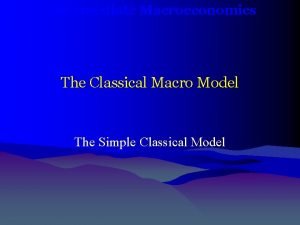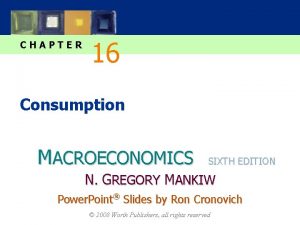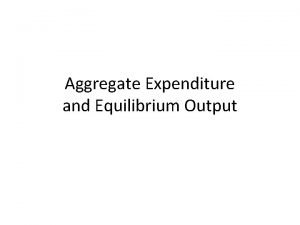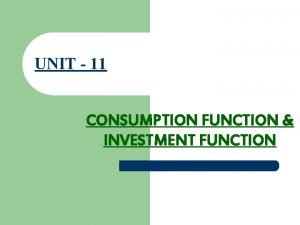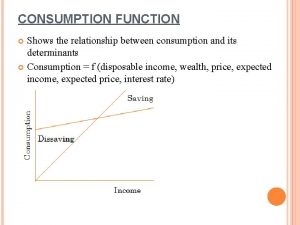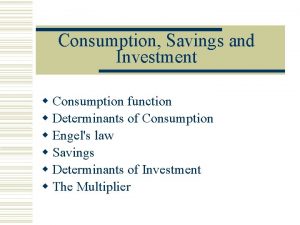Consumption Function Consumption Function CF Greater part of















- Slides: 15

Consumption Function

Consumption Function (CF) Ø Greater part of Chapter 8 & 9 of the General Theory are devoted to factors which underlie CF and determined its form i. e. slope and position of the curve Ø One section devoted to factors which cause shift in CF Ø According to Classical Ects. consumtion was an inverse function of (r) Ø Keynes advanced the hypothesis that consumption depends primarily on real income - as real income ↑es, cons. will also ↑ Ø Keynes propounded CF in terms of “Fundamental Psychological Law of Consumption”

Ø He said “men are disposed, as a rule and on the average, to increase their consumption as their income increases but not by as much as the increase in income” Ø Thus according to Keynes, when Y ↑es, C will also ↑ but ↑ in C < ↑ in Y i. e. ΔC < ΔY or MPC is positive but less than one i. e. 0 < MPC < 1 Ø Keynes further argued, though with less confidence, that as income ↑es proportion of Y allocated to consumption C/Y ↓ i. e. as Y↑es, APC ↓ Ø By income Keynes meant disposable income

Ø Thus elements of Keynsian hypothesis are: 1. C varies directly with Y 2. 0 < MPC < 1 3. As Y ↑es, C/Y↓es Ø A no. of forms can satisfy this hypothesis but let us consider a relationship C = a + b. Y (a > 0, 0 < b < 1) Ø a & b are constants called parameters- equ indicates C is a linear form of Y Ø Here a shows autonomous cons and b induced cons. b is MPC = ΔC/ΔY Ø Linearity is assumed because empirical evidence suggests that CF is linear or approximately so

Ø The following diagram shows Keynsian CF 45° C C = a + b. Y O Y 0 Y Ø In the above diagram C = a+b. Y depicts Keynsian CF Ø It shows that MPC is positive but < 1, and as Y ↑es C/Y i. e. APC ↓es. At income Y 0 APC = 1 below Y 0, APC > 1 and above Y 0, APC < 1 Ø It shows that APC ↓es as Y ↑es.

Ø This implies that proportion of income that is saved ↑es with ↑ in N. I. Ø This result also follows from the studies of family budgets of various families at different levels of income. Ø This CF implies that to achieve and maintain equ. at full empt. ↑ing proportion of N. I. is to be invested Ø If sufficient invt. opportunities are not available, economy would run into trouble and it will not be possible to maintain full empt. because A. D. will fall short of full empt. level Ø Earlier studies based on cross-sectional budget studies appeared to confirm this relationship Ø These budget studies show a relationship between family C and family Y like that which Keynes postulated for the economy

Ø If a straight line is fitted to the data by regression analysis or some other technique, the line interests vertical axis at a positive level consumption and has a slope ranging between 0. 6 to 0. 8 Factors determining CF: Keynes divided factors determining CF in two groups: 1. Subjective Factors, (endogenous) 2. Objective Factors (exogenous or external to the economic system) Ø Subjective factors include: I. Psychological characteristics of human nature, and II. Social practices and institutions, (specially the behaviour pattern of business concerns w. r. t. wage and dividend payments and retained earnings), and social arrangements such as those affecting distribution of income

Ø According to Keynes, subjective factors are unlikely to undergo a material change over a short period of time except in abnormal or revolutionary circumstances - likely to be fairly stable. Ø These are slowly changing factors, fundamentally determine slope and position of C. F. and serve it to give a family high degree of stability Ø External factors may undergo rapid change and may cause marked shifts in the CF Ø Among subjective factors are included those factors which induce and prompt people to save

Ø Keynes lists 8 such motives: 1. Building of reserves for unforeseen contingencies. 2. Provision for anticipated future needs 3. Desire to enjoy an enlarged future income by investing funds out of current income 4. Enjoyment of a sense of independence and power to do things 5. To carry out speculation or business project 6. Bequeathing a fortune, and 7. Satisfaction of pure miserliness – accumulation of wealth give them a greater psychic satisfaction

Subjective factors also apply to behaviour pattern of business corporations and governmental bodies Ø Keynes listed four motives for accumulation by bus. corporations & govt. , 1. Enterprise – the desire to do big things to expand 2. Liquidity – the desire to face emergencies successfully 3. Rising incomes – the desire to demonstrate successful management 4. Financial Prudence – the desire to ensure, adequate financial provision against depreciation and obsolescence and to discharge debt. Ø Keynes laid great stress on behaviour of bus. concerns w. r. t. depreciation & other reserves and how these practices affect amount of C in relation to Y

Objective Factors: Keynes lists six objective factors which may cause substantial shifts in CF 1. Windfall gains or losses 2. Changes in General Price Level and wage levels ↑ P => ↓ Shift in C. F. through RBE 3. Changes in Fiscal Policy – ↑ T => ↓ MPC 4. Changes in expectations 5. Substantial changes in (r) 6. Changes in accounting practices w. r. t. depreciation etc.

Ø Propensity to consume does not change, generally, in the short-run because it depends more on psychological and institutional factors which change only in long-run Ø Therefore, Keynes was of the view that CF remains stable in the short-run Ø Because of focus on the observed income as driving force behind consumption, Keynsian CF is referred to as Absolute Income Hypothesis. Earlier Keynsians were enthusiastic about CF analaysis for two reasons: 1 - If a stable relationship between C & Y exists, amount of Invt. , govt. purchases and taxes necessary to achieve full empt. Can be determined.

2 - Earlier studies based on cross sectional budget studies appeared to confirm relationship between family C and family Y as postulated by Keynes for the economy. Ø If a straight line is fitted to the data by regression analysis or some other technique, line intersects vertical axis at a positive level of C and has a slope ranging between 0. 6 to 0. 8. Ø Keynsian hypothesis of ↓ing APC with rise in income has not been borne out in practice in the long run Ø In 1946, Simonn Kuznet in his empirical study of Time Series Data of U. S. during period 1869 -1938, has found that despite continued growth in real income or GNP, APC has not ↓ed and APS has not ↑ Ø Kuznet found that APC has remained almost stable or constant throughout this long-period - estimated to be around 0. 9 Ø Therefore long-run C. F. is linear of the form C = b. Y implying that C was approximately zero when Y is zero i. e. CF. passes through the origin.

45° C c = by Y Ø Kuznet’s long-run CF shows that there is proportional relationship between C & Y i. e. long-run APC is constant and MPC = APC and both are constant Ø This is contrary to Keynes’ theory of CF and also contradicts findings of cross-sectional family budget studies, became a puzzle for ects called “Consumption Puzzle

→ Two types of data were used to test Keynsian absolute income hypothesis i. e. (i) Cross-section data (ii) Time-section data Ø Cross section data reflect the relative behaviour of a group of individuals at some point of time. Time series data capture the pattern of aggregate behaviour or a time span. Ø Later on, theories of C. F. succeeded in resolving this puzzle. Important theories resolving cons. puzzle are as follows; 1 - Life Cycle Hypothesis – Franco Modigilani 2 - Permanent Income Hypothesis – M. Friedman 3 - Relative Income – James Dusenbry
 Afqt
Afqt Keynesian consumption function
Keynesian consumption function Consumption function formula
Consumption function formula Keynesian consumption function
Keynesian consumption function Autonomous expenditure formula
Autonomous expenditure formula Part part whole addition
Part part whole addition Unit ratio definition
Unit ratio definition Brainpop ratios
Brainpop ratios Technical descriptions
Technical descriptions What are the basic display parts of the bar
What are the basic display parts of the bar The phase of the moon you see depends on ______.
The phase of the moon you see depends on ______. Part to part variation
Part to part variation World tea consumption
World tea consumption Rdimm power consumption
Rdimm power consumption Canadian tea market overview
Canadian tea market overview School water audit
School water audit

